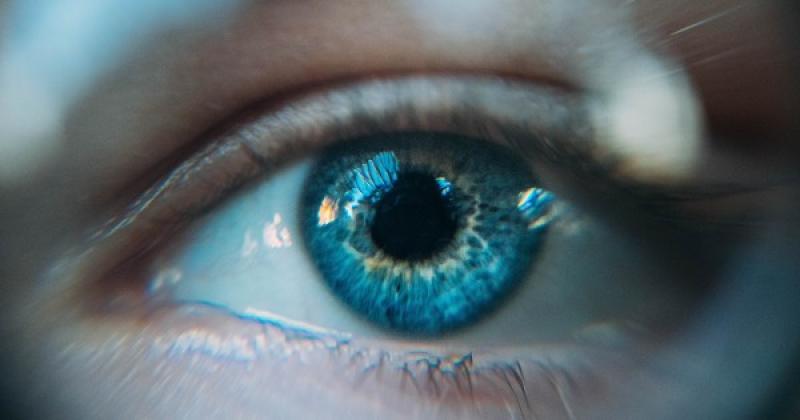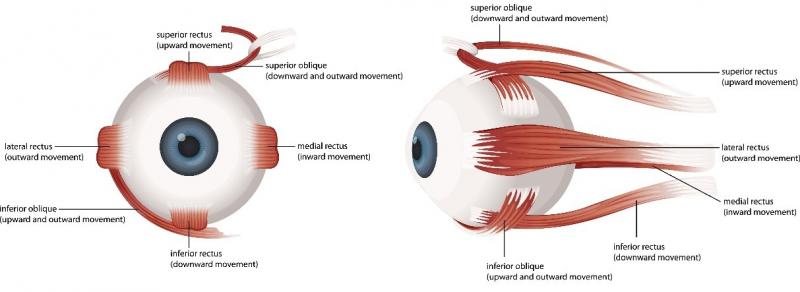Did you know your eye muscles can be trained?
12th Apr 2021
The muscles of the eye
Each of our eyes is controlled by six muscles (called the extraocular muscles) which work together to create the movements of the eyeball. These muscles work in the same way as any other skeletal muscles, such as your hamstrings or your biceps, in that they adapt to the stresses and strains that are put upon them; in other words, they respond to training! The eye muscles are already as strong as they need to be (our eye-balls are not getting any heavier!), but we can train them to work faster, more efficiently, in better coordination with each other. We can also improve their stamina so that they can work for longer periods of time without getting fatigued.

[above] The six extraocular muscles
These muscles are really important for many aspects of vision involved in any athlete’s performance. If you can point your eyes somewhere more quickly, then that information can get sent to your brain for processing sooner – and you can get a head start over your opponent. If these eye movements are more accurate, then you will be able to watch a moving object more closely. This will enable you to perform tasks such as volleying a football cleanly, or breaking later in to a corner when racing. If your eyes can work for longer periods without getting tired, then you will be able to perform at a high level, even in the final minutes of your competition.
Too much screen time is not great
There are three other muscles in the eye which are important to your vision. The first of these is the ciliary muscle. The ciliary muscle is responsible for moving and stretching the lens of the eye to focus the eye at different distances. When you need to see something close up, the ciliary muscle contracts to bring it into focus. It relaxes when looking into the distance. This tightening of the ciliary muscle can sometimes lead to problems. If you are focusing on something close up for long periods of time (such as playing games on your phone or working on a computer) this muscle has to contract to keep what you are looking at in focus. This can lead the ciliary muscle to go into spasm. If you had your eyes tested at this time, it would seem as though you have become short-sighted, because this muscle is not able to relax and focus far away. This is something that often happens to young athletes when they suddenly start cramming for exams.
You can make them faster, more accurate, and increase their stamina.
In the modern world, where we spend so much more time focusing on our phones or tablets, we are all at risk of this happening which is bad news for the type of vision we need to play sport! There is good news though – there are exercises which will reduce the risk of having these ciliary spasms and the resulting reduction in distance vision. Even just making sure you move your focus away from the screen, to look at something in the distance on a regular basis can make all the difference.
How fast are your eyes?Hold your arms out straight in front of you, just wider than your shoulders and hold up your index fingers. Now, while keeping your head still, see how many times you can look at each index finger in one minute. You will probably notice your eyes getting tired and slowing down towards the end of the minute. Repeat this test on a regular basis and see if you are getting any quicker. Are your eyes slower at particular times of day? If you hold your arms above your head (keep your head angled straight, so your eyes are having to point upwards) and repeat this task, do you notice any differences? For most people, this position will cause slower eye movements and the eyes will feel tired more quickly as more of the eye muscles are having to be used together. Think about the angles your eyes will have to work at when performing your sport and see if you can train them in that plane. |
The remaining two muscles of the eye are in the iris (the coloured part of the eye) and these muscles are responsible for opening and closing the pupil to allow more, or less, light into the eye. These muscles work on their own (without you having to think about it) so cannot be trained. They will become slower to react as you get older (over about 40), at which point some tinted lenses may help you to continue to perform at the highest level.
Training is key
All these muscles play a major part in how our eyes work – they move the eyeball to look at what the brain has told them to, they control the amount of light coming into the eye, and they focus that light in the right place. This is the first step in collecting the information you need to play your sport so making sure they are in good health, and then training them to work to their maximal potential could be the difference between winning and losing.